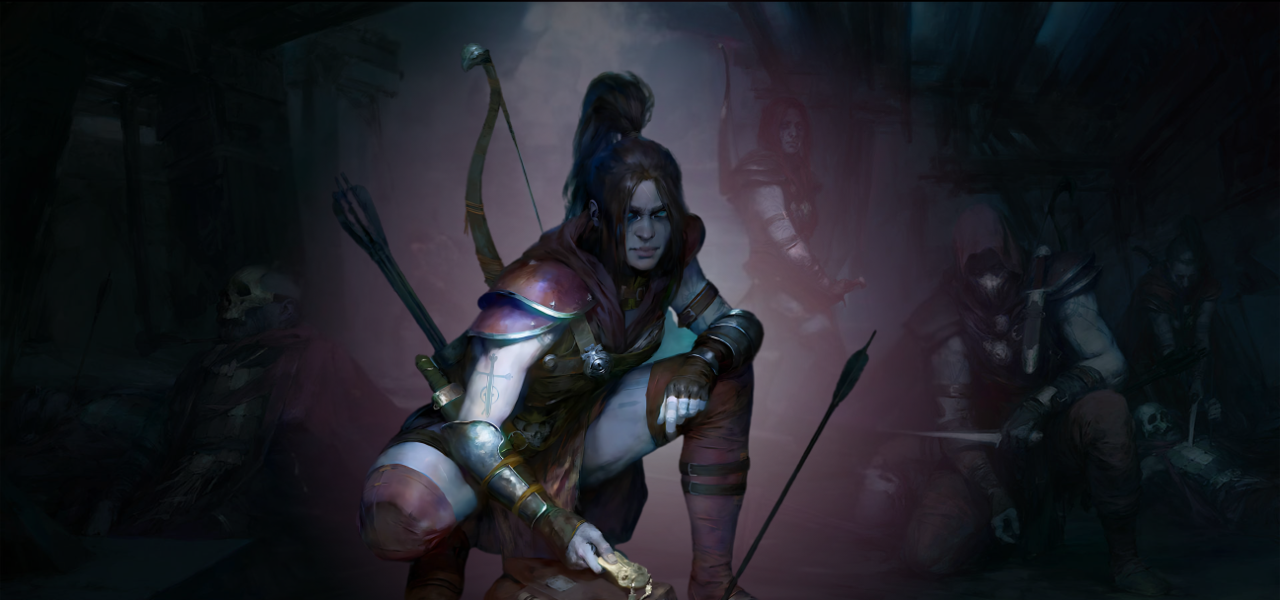Diablo IV – Blind Demon Slayers Take the Battlefield
🔥 Introduction
Diablo IV is the long-awaited continuation of Blizzard’s iconic franchise, bringing back the dark atmosphere, open world, and relentless demons. But how accessible is the game for completely blind players? Let’s break down all the accessibility updates and improvements!
📖 Story and Development Background

Diablo IV centers around the return of Lilith, daughter of Mephisto, who brings destruction to Sanctuary. Players must explore a grim world filled with cults, ancient secrets, and bloody rituals.
Blizzard announced the game in 2019, promising the dark aesthetic of Diablo II combined with MMO elements and an open world. After several years of development, the game launched in 2023 and has since received many updates — including major accessibility improvements.
Gameplay
Diablo IV is an action-RPG with an isometric view, a gloomy atmosphere, and a strong focus on loot. Players explore an open-world Sanctuary, complete quests, battle hordes of demons and bosses, and level up their characters by improving skills and gear. The gameplay emphasizes fast-paced combat, co-op, and PvP content.
Available Classes
Currently, Diablo IV offers the following classes:
- Barbarian – a powerful melee warrior with diverse weapons and high stamina.
- Sorceress – a master of elemental magic (fire, ice, lightning), dealing high ranged damage.
- Druid – a versatile shapeshifter who can control the forces of nature.
- Necromancer – a dark caster who summons the undead and manipulates blood and shadow magic.
- Rogue – a nimble fighter adept in both melee and ranged combat, using traps and poisons.
- Spiritborn – a new class introduced in the Vessel of Hatred expansion. Agile and deadly, it uses poisonous and fiery attacks and can summon companions with unique skills.
Core Activities in the Game
In Diablo IV, players can:
- Explore the world – travel across the open-world Sanctuary, discovering hidden areas and secrets.
- Complete quests – progress through the main storyline and side missions, interacting with a range of NPCs.
- Fight enemies – engage with hordes of demons and epic bosses using class-specific abilities.
- Gather and enhance gear – loot powerful weapons and armor and customize them to fit your playstyle.
- Join events – take part in world events like demon invasions or town sieges.
- Play with others – team up with friends in co-op adventures or compete in PvP modes.
These elements make Diablo IV’s gameplay rich and immersive, offering players numerous ways to interact with the world and develop their characters.
Sound Design and Soundtrack
The entire world of Diablo IV reveals itself to me purely through sound. And honestly, Blizzard delivered an absolutely fantastic sound design and soundtrack that makes the game feel deep, immersive, and incredibly rich.
The first thing that stands out is the wealth of the sound palette. Each location has its own distinctive sound, creating a clear sense of space and place.
- Environment and surroundings: In the snowy mountains, you hear the howling wind, the crunch of snow underfoot, and the distant cries of wild beasts. In the swamps—wet footsteps, splashing water, and the drone of mosquitoes. In the deserts—dry sand, pebbles crunching underfoot, and distant predator calls.
- Towns and settlements: The sounds of blacksmiths, merchants, and NPC conversations all contribute to the effect of a living world. Entering a tavern, the chatter softens and becomes more intimate—you can hear the crackling of the fire.
- Dark dungeons: Dripping water, echoing footsteps, bones crunching underfoot, and the eerie screech of unseen enemies—all this creates tension, even without visuals.
Combat
Blizzard did an amazing job with combat sound effects. Each type of attack has its own unique feel:
- Crushing axe blows sound dull and bone-shattering.
- Swift sword strikes slice through the air with metallic sharpness.
- Magic is its own symphony: fireballs roar, lightning crackles, ice creaks and freezes enemies with a chilling snap.
Enemies deserve a special mention—you can often tell who you’re facing just by the sound. Demons growl, witches whisper hauntingly, skeletons clatter, and elite monsters have distinct audio cues that signal their danger.
Soundtrack
The musical score is a blend of dark ambient, gothic choirs, tense strings, and rare melodies that wash over you in waves, creating a dark but hypnotic atmosphere.
- In the open world, music remains subdued, allowing you to immerse yourself in the eerie emptiness of dark fantasy.
- During boss fights, the themes become dramatic and almost cinematic, building tension and making your heart race.
- Towns sound peaceful, with light medieval motifs, but there’s always a touch of sadness and doom in the background.
In summary, the sound design in Diablo IV is not just an add-on—it’s a core part of the gameplay, enabling you to quite literally “see” the world, navigate in combat, and feel its atmosphere. Even without visuals, the game remains incredibly vivid—and hauntingly beautiful.
🎮 Accessibility: How Much More Playable Has the Game Become for Blind Players?

Blizzard has made significant improvements in accessibility, making Diablo IV much more user-friendly. The game can now be completed entirely without vision, though there are still some inconveniences, which we’ll discuss below.
✅ Accessibility Improvements:
- Sound-based navigation in the open world: You can now orient yourself using audio cues, making it much easier to move through Sanctuary. Unfortunately, navigation in dungeons remains unavailable.
- Full support for screen reader software: All important UI elements are now readable by screen readers, including inventory, menus, and item descriptions.
- Audio cues for interactions: Signals for loot, objects, and combat events have been enhanced.
- Auto-targeting for attacks: Makes it easier to hit enemies, especially when facing groups.
❌ Remaining Issues:
- Dungeons are still difficult to navigate: Unlike the open world, they lack sound navigation features.
- Combat mechanics still need refinement: While auto-targeting works, dodging and tactical movement remain challenging without visual feedback.
- Quest markers don’t always track properly: In complex areas, audio indicators sometimes fail to guide players accurately.
⚖️ Conclusion
The updates have made Diablo IV significantly more accessible for blind players, especially thanks to audio navigation and improved screen reader support. However, dungeons remain a major obstacle, and combat mechanics still require further adaptation.
Blizzard is moving in the right direction, but for full accessibility, the game still lacks improved dungeon navigation and more detailed combat audio cues. That said, it’s worth recognizing that despite some remaining flaws, blind players can now complete the game with a bit of patience and a few clever tricks—like dropping unwanted items in dungeons to mark the way, breadcrumb-style 😀.
